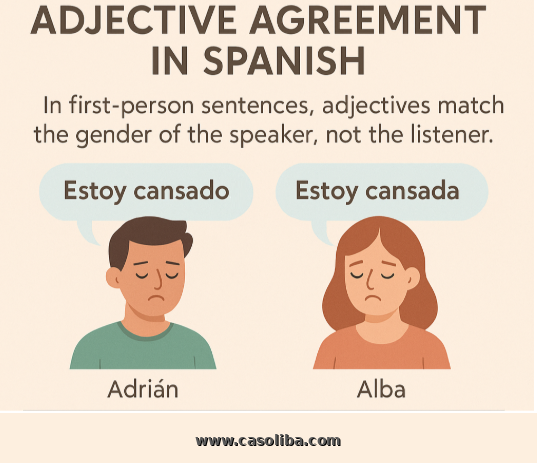Understanding Gender Agreement in Spanish First-Person Statements
One of the most common mistakes made by Spanish learners is assuming that adjectives change according to the person being spoken to.
In reality, in Spanish the adjective changes according to the speaker’s own gender, not the listener’s.
1. The Gender Belongs to the Speaker
In Spanish, when I say «Estoy cansado» (I’m tired), the word cansado agrees with my gender.
If I’m a man, I say cansado.
If I’m a woman, I say cansada.
Example:
-
Carlos (male) says: «Estoy ocupado» → I’m busy.
-
Laura (female) says: «Estoy ocupada» → I’m busy.
It doesn’t matter whether Carlos is speaking to a man or a woman — the form of the adjective will stay the same, because it reflects the speaker, not the listener.
2. How This Applies to Devices with Voices
Let’s imagine a smart assistant with two voice options:
-
Adrián → male voice
-
Alba → female voice
If Adrián is speaking:
-
He will always say «Estoy ocupado», «Estoy cansado», «Estoy contento», etc.
If Alba is speaking:
-
She will always say «Estoy ocupada», «Estoy cansada», «Estoy contenta», etc.
The gender is tied to the “character” or persona speaking — not to the end user listening.
3. Practical Examples
Scenario 1: Adrián (male voice) speaking to Marta (female user)
-
Adrián says: «Estoy cansado» ✅ Correct
Scenario 2: Alba (female voice) speaking to Juan (male user)
-
Alba says: «Estoy cansada» ✅ Correct
Scenario 3: Common mistake
-
Alba (female voice) speaking to Juan (male user): «Estoy cansado» ❌ Incorrect
Even though the user is male, Alba is female, so it should be «Estoy cansada».
4. Common Adjectives in First-Person Phrases
| English | Masculine Form | Feminine Form |
|---|---|---|
| Tired | cansado | cansada |
| Busy | ocupado | ocupada |
| Happy | contento | contenta |
| Worried | preocupado | preocupada |
| Ready | listo | lista |
| Sick | enfermo | enferma |
| Angry | enfadado | enfadada |
| Relaxed | relajado | relajada |
| Nervous | nervioso | nerviosa |
| Confident | seguro | segura |
5. Golden Rule
In first-person statements, the adjective always matches the speaker’s gender — never the listener’s.
6. Why This Matters in Translation and Voice Design
If you’re translating scripts, programming AI voices, or creating automated messages in Spanish, this detail is crucial for sounding natural and grammatically correct.
A mismatch in gender agreement can make the phrase sound jarring or even incorrect to native speakers.
💡 Conclusion:
Whether it’s a real person or a virtual voice, Spanish adjectives in first-person statements should always agree with the speaker. Keep this rule in mind, and you’ll avoid one of the most frequent (and easy-to-fix) errors in Spanish grammar.

0 Comments Add a Comment?